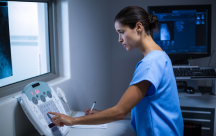April 07, 2024
Picture Archiving and Communication Systems (PACS) revolutionized the landscape of medical imaging by introducing digitalization and streamlining the management of medical images. The role of PACS in modern medicine encompasses a wide array of functions and benefits that significantly impact patient care, clinical workflows and overall healthcare efficiency. At its core, PACS serves as a centralized system for storing, retrieving, distributing, and viewing medical images, including X-rays, computed tomography (CT) scans, magnetic resonance imaging (MRI), ultrasound, and nuclear medicine images.
Traditionally, medical images were captured on film and stored physically, leading to cumbersome and time-consuming processes for retrieval and sharing. PACS digitizes these images, allowing healthcare providers to access them instantly from any location within the healthcare network, facilitating rapid diagnosis and treatment decisions.
One of the primary roles of PACS is to enhance diagnostic capabilities by providing healthcare professionals with immediate access to high-quality images. This quick access to medical images enables radiologists, physicians, and specialists to review and interpret images promptly, leading to faster diagnosis and improved patient outcomes. Additionally, PACS facilitates comparison of current images with previous studies, aiding in the detection of subtle changes over time and enhancing diagnostic accuracy.
PACS also plays a critical role in promoting collaboration and communication among healthcare providers. Through PACS, medical images can be easily shared between different departments, healthcare facilities and even remote locations, fostering interdisciplinary teamwork and enabling consultations among specialists. This seamless exchange of information accelerates the decision-making process, particularly in complex cases where input from multiple experts is required. PACS contributes to operational efficiency within healthcare organizations by optimizing workflow management.
With PACS, images can be electronically routed to the appropriate personnel for review and interpretation, eliminating the need for manual transport of physical films and reducing the risk of errors or delays. This automation streamlines the imaging process, improves productivity and allows healthcare professionals to focus more time on patient care.
PACS eliminates the need for physical storage space required for film archives, reducing costs associated with film procurement, maintenance and retrieval. Moreover, digital images stored within PACS are easily searchable and can be archived securely for long-term retention, ensuring accessibility for future reference and research purposes.
PACS serves as a foundation for advanced imaging technologies and innovations, such as 3D reconstruction, computer-aided diagnosis (CAD), and artificial intelligence (AI) applications. These technologies leverage the digital infrastructure provided by PACS to enhance diagnostic accuracy, automate image analysis and assist healthcare providers in making more informed decisions.
Shivangi Sharma
Faculty of Radiology

















